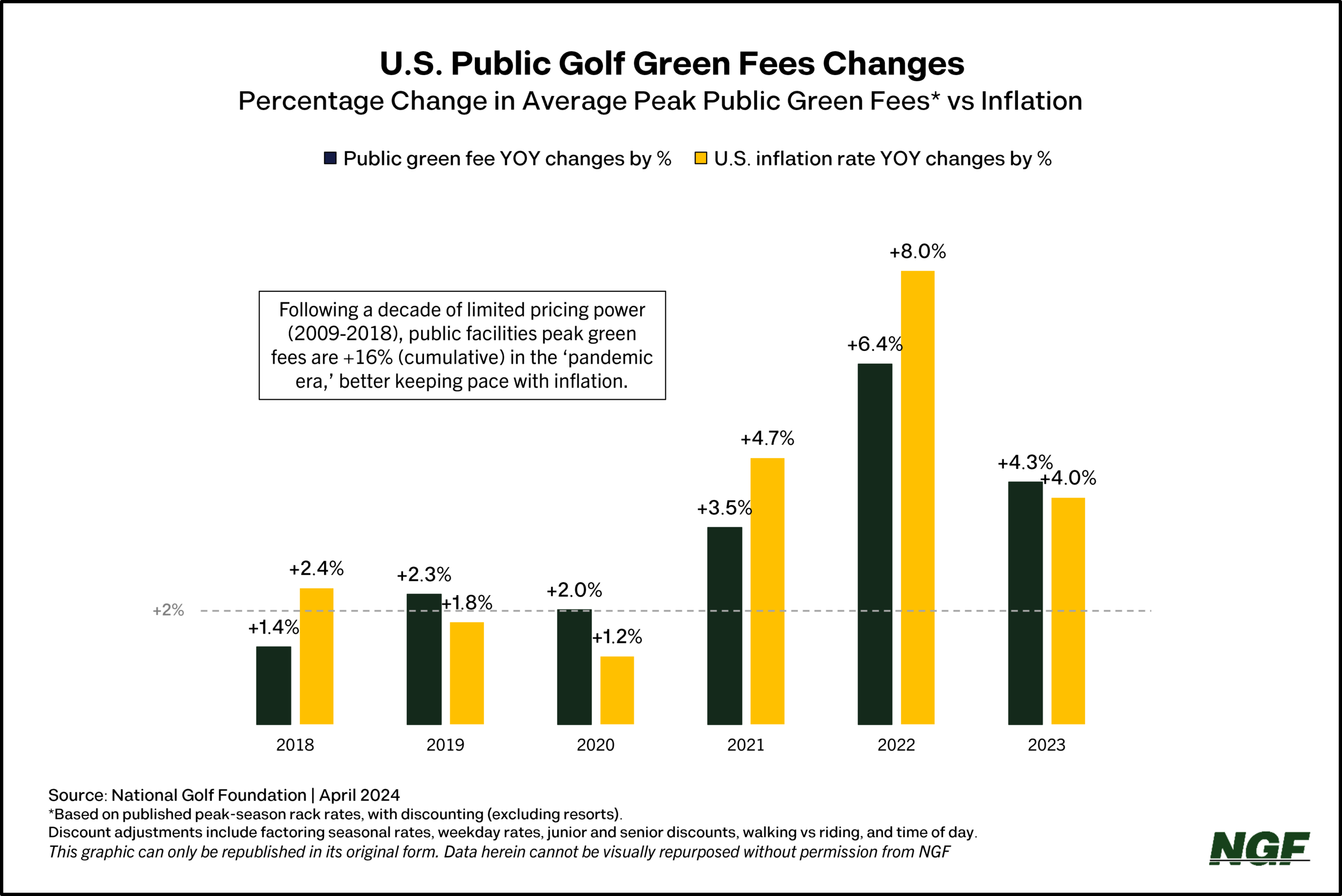The (Rising) Cost of Golf?
(🔉 Click to listen to the audio version)
NGF’s founder, Herb Graffis, the legendary industry pioneer and first journalist inducted into the World Golf Hall of Fame, was noted for saying it’s the recreational golfer from whom all blessings flow.
And green fees are the greatest “blessing” of them all. The money golfers pay to play benefits the nearly 14,000 green-grass golf facilities across the country and extends to the thousands of companies and suppliers that support golfers and help courses deliver the industry’s #1 product — the game itself.
The golf business overall is cyclical. When some categories thrive, others may not necessarily do as well.
For the first time in a generation, golf courses are perhaps the business segment enjoying the greatest benefit from the current surge.
Since the start of 2020, the number of annual U.S. rounds is trending 12% above the 10-year pre-pandemic average. Meanwhile, over the past four years, peak 18-hole green fees at public facilities have climbed more than 16% cumulatively, per an analysis of the NGF’s definitive golf course database. These recent increases follow a decade of supply/demand imbalance (oversupply) that limited courses’ pricing power. This stretch, on the heels of the Great Recession, saw public green fee increases on a scale that trailed U.S. inflation rates.
Increased demand is the driving force behind green fee increases (have you tried to secure an 8 a.m. tee time on a Saturday lately?), but not the only reason. Some facility operators also cite their need to offset increased costs related to labor, supplies, and maintenance. Others are seeking to keep pace with competitors within their market.
But the healthy balance between supply and demand means golf operators have been able to raise prices meaningfully in recent years and still have full tee sheets. It also means they’re able to do more to invest in and improve their product. A recent operator survey found almost half (49%) of public facilities and 62% of private facilities undertook “significant” course-or-clubhouse related capital investments over the past year. Increased revenues and improved financial health means golf courses can pursue investments like new cart fleets, maintenance equipment, driving range technology, enhanced drainage/irrigation, turf and chemicals and better bunkers to catch your errant shots.
Even so, the average U.S. public 18-hole fee – when accounting for discounts* — is still just north of $37 when excluding resorts. That’s up from about $32 in 2020. (Note that published peak-time fees, the pricing data NGF tracks, aren’t always paid at rack rate – but clearly the necessity to discount is diminished these days).
Golf’s recent revival has come “at a cost,” of sorts, anyway. But rising green fees — overdue when compared to inflation – very much reflect the improved supply and demand balance, and, more broadly, the improved health of the game.
Short Game.
"*" indicates required fields
How can we help?
NGF Membership Concierge

"Moe"
Learn From NGF Members
 Ship Sticks Secrets to a Hassle-Free Buddies Golf Trip
Ship Sticks Secrets to a Hassle-Free Buddies Golf Trip
Whether you’re the head planner of your upcoming buddies golf trip or simply along for the ride, we’ve gathered a few easy ways to keep everyone in your group happy.
Read More... Golf Course Turf, Soil and Water Quality Diagnostic Testing
Golf Course Turf, Soil and Water Quality Diagnostic Testing
As humans, we see our primary care physician on a regular basis to proactively evaluate our vital signs. Likewise, a superintendent should perform frequent diagnostic testing on their golf course.
Read More... Unlocking Distance: Launch Conditions and Angle of Attack
Unlocking Distance: Launch Conditions and Angle of Attack
We’ve long known that higher launch and lower spin is a powerful combination for generating consistently long and straight tee shots. A key factor in optimizing launch conditions, one often overlooked, is ...
Read More...






